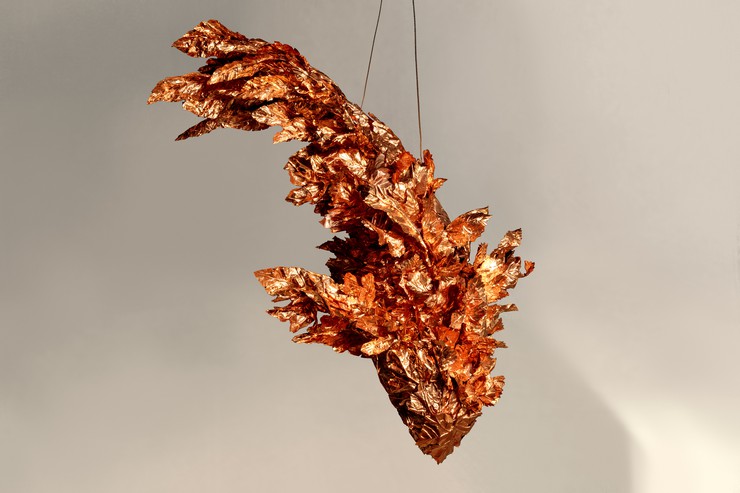
Frank Gehry: Spinning Tales | Nancy Rubins: Fluid Space
456 N Camden Dr., Beverly Hills, CA 90210
Thursday, June 24 at 10:00 AM – 5:30 PM
Ends Aug 6, 2021
Ends Aug 6, 2021
Frank Gehry: Spinning Tales
June 24 - August 6, 2021
"When I built the first model of the fish, I saw in it the movement that I was looking for. It was startling that a static object could express motion in such a dynamic way."
—Frank Gehry
Gagosian is pleased to present Spinning Tales, an exhibition of new work by renowned architect Frank Gehry. It pairs large-scale elaborations on the Fish Lamps series with a new installation, Wishful Thinking (2021), and is Gehry’s eighth exhibition with the gallery since 1999.
Celebrated for his groundbreaking architectural designs, Gehry has also produced significant bodies of sculpture and furniture, from Easy Edges (1969–73) and Experimental Edges (1979–82)—chairs and tables made from layers of corrugated cardboard—to bentwood furniture items designed for Knoll (1989–92). The Fish Lamps evolved from a 1983 commission by the Formica Corporation to utilize ColorCore, a type of plastic laminate. After accidentally breaking off a shard of the material, Gehry was inspired by its scale-like appearance; molding wire armatures into piscine forms, he affixed ColorCore fragments to them.
In the main gallery, three outsize, internally illuminated Fish Lamps sculptures are suspended from the ceiling in dynamic, twisting poses, as if swimming through water. In these works, Gehry has used polyvinyl and copper for the first time. These central forms are surrounded by lively, colorful sculptures that are more baroque in their ornamentation. While these sculptures are autonomous works, the “perfect form” of the creature that they emulate reappears throughout Gehry’s architectural oeuvre, lending itself to the undulating profiles of buildings including the Guggenheim Bilbao, Spain (1997), and the Walt Disney Concert Hall, Los Angeles (2003).
Filling the upstairs gallery is the immersive installation Wishful Thinking, based on a scene from Alice’s Adventures in Wonderland. Gehry renders the Mad Hatter’s tea party as a group of ten surreal figures, twice life-size. Fashioned from brilliantly painted metal, Gehry’s abstracted interpretations of Carroll’s original characters surround an internally lit table, the glowing heart of the scene. Three overlapping woven steel “tapestries” of trees evoke the episode’s forest setting, while a mirror on the opposite wall implicates the viewer. The crumpled surfaces of Wishful Thinking’s figures establish a new visual connection with some of Gehry’s best-known designs.
----------------
Nancy Rubins: Fluid Space
June 24 - August 6, 2021
"I realized that this stuff has been around a long time, and it’s passed through this odd transition. Before it was in the earth, it was floating as a molecule in outer space—it was part of somebody’s star, or part of somebody’s exploding planet."
—Nancy Rubins
Gagosian is pleased to present Fluid Space, an exhibition of recent sculptures and drawings by Nancy Rubins.
Since the late 1970s, Rubins has transformed industrial and found objects—everything from television sets and airplane parts to canoes and carousel animals—into engineered abstractions following rhizomatic patterns. Her first public project, Big Bil-Bored (1980) was commissioned for the Cermak Plaza shopping center in Berwyn, Illinois, and she has continued to work on a large scale ever since; Big Pleasure Point, a structure composed of more than sixty small water vessels, was installed outside New York’s Lincoln Center for the Performing Arts in 2006.
In Fluid Space (2019–), the series from which the exhibition takes its title, Rubins uses the same cast metal animals that appeared in her Diversifolia series (2016–18), now sliced into fragments that expose their seams and undersides, calling further attention to the shape-shifting potential of the metal itself. These quasi-organic structures bloom from tables and stools, recalling works such as Table & Airplane Parts (1990–2011), which incorporate architectural foundations from which disparate elements emerge.
In sculptures such as Fizzy’s Nebuli and Noir’s Cluster (both 2019), parts of the cast animals are bound together by webs of tensile cables, producing configurations that are no longer legible as fauna, reading instead as structures that approximate rosebuds or ivy tendrils. The sculptures’ titles also emphasize their correspondence with cosmic and cellular phenomena. In these and other works, Rubins testifies to her chosen materials’ resilience while also hinting at ongoing processes of change.
Also on view are large-scale and smaller unmounted drawings on paper, fixed directly to the wall in Rubins’s customary manner. She covers the entire surface of the thick paper with graphite, producing a dense, shiny, steel-gray expanse that bears traces of her hand and gives the impression of bottomless depth. In the larger drawings, multiple sheets of paper are combined and folded so that they arc away from the wall, echoing the forms of some sculptures.
